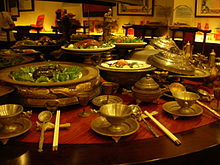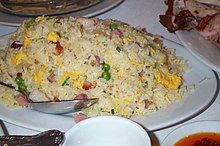Chinese cuisine
This article needs additional citations for verification. (April 2009) |
| Part of a series on |
| Chinese cuisine |
|---|
 |
Chinese cuisine is a term for styles of food originating in the regions of China, many of which have become widespread and popular in other parts of the world — from Asia to the Americas, Australia, Western Europe and Southern Africa. Where there are historical immigrant Chinese populations, the style of food has evolved–for example, American Chinese cuisine and Indian Chinese cuisine are prominent examples of Chinese cuisine that has been adapted to suit local palates. In recent years, connoisseurs of Chinese have also sprouted in Eastern Europe and South Asia. The culinary Michelin Guide has also taken an interest in Chinese cuisine, establishing Hong Kong and Macao versions of its publication.
Presentation

In most dishes in Chinese cuisine, food is prepared in bite-sized pieces, ready for direct picking up and eating. In traditional Chinese cultures, chopsticks are used at the table.
Traditional Chinese cuisine is also based on opposites, whereby hot balances cold, pickled balances fresh and spicy balances mild.
Contemporary health trends



According to the United Nations Food and Agriculture Organization estimates for 2001–2003, 12% of the population of the People’s Republic of China was undernourished.[1] The number of undernourished people in the country has fallen from 386.6 million in 1969–1971 to 150.0 million in 2001–2003.[2]
Prior to the increased industrialization and modernization following the establishment of the People's Republic of China in 1949, a typical Chinese peasant would have eaten meat or animal products (including eggs) rarely and most meals would have consisted of rice accompanied with green vegetables, with protein coming from foods like peanuts and soy products. Fats and sugar were luxuries not eaten on a regular basis by most of the population. With increasing wealth, Chinese diets have become richer over time, consuming more meats, fats, and sugar.
Health advocates put some of the blame on the increased popularity of US foods, especially fast food, and other culinary products and habits. Many US fast food chains have appeared in China, and are highly successful economically. These include McDonald's, Pizza Hut, and Kentucky Fried Chicken (KFC).
An extensive epidemiological study called the China Project is being conducted to observe the relationship of disease patterns to diet, particularly the move from the traditional Chinese diet to one which incorporates more rich US-style foods. Controversially, Professor T. Colin Campbell, an "outspoken vegan",[3] has implicated the increased consumption of animal protein in particular as having a strong correlation with cancer, diabetes, heart disease, and other diseases that, while common in Western countries, were once considered rare in China. He suggests that even a small increase in the consumption of animal protein can dramatically raise the risk of the aforementioned diseases.[citation needed]
Notes
- ^ "Country Profiles" (PDF). Statistical yearbook. FAO. Retrieved 2008-04-25.
- ^ "Undernourished persons by country". Food security statistics. FAO. Retrieved 2008-04-25.
- ^ Activistcash.com
External links
- ‹The template Curlie is being considered for deletion.› Chinese cuisine at Curlie
- Times Online Ching He Huang 10 basic ingredients for Chinese cooking
- BBC TWO Chinese food made easy
- Chinese Food Flavor Map
- Regional chinese cuisines, edu site
- Chinese Restaurants Are Adding Herbs for Flavor and Health - The New York Times
- Chinese Eight Cuisines
